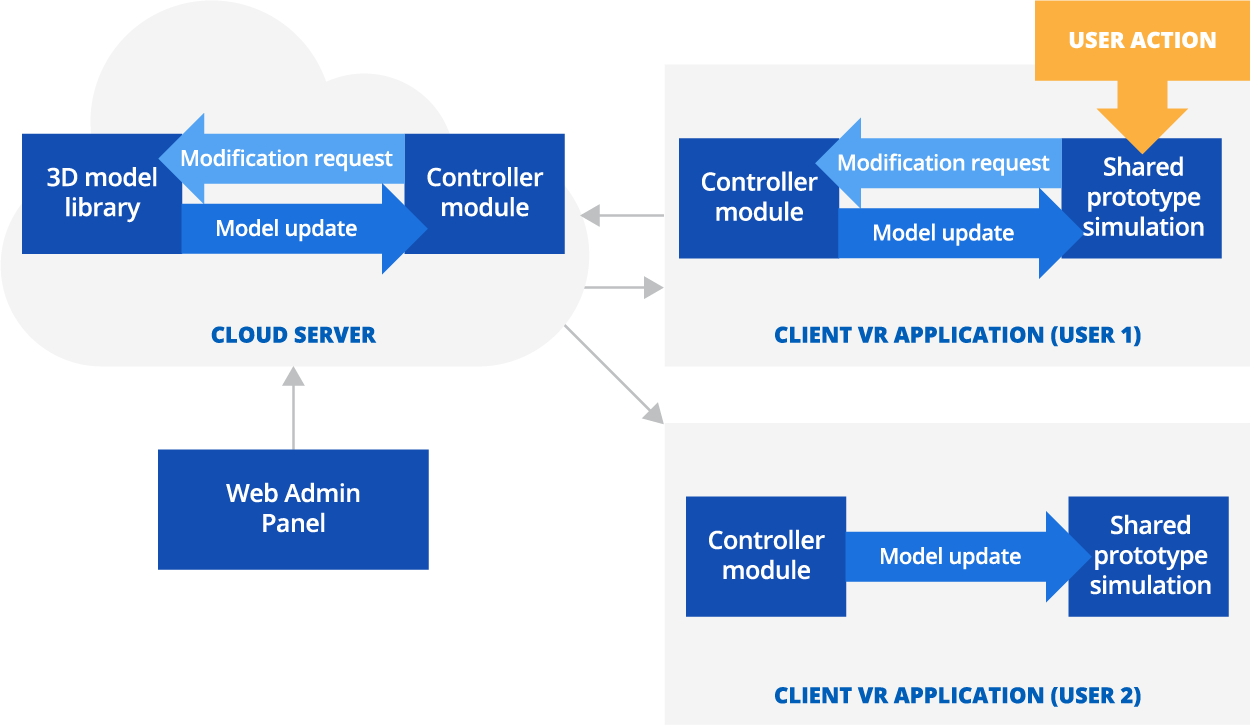Virtual Reality for Prototyping: Industry Use Cases, Architecture, Costs
Powered by 36 years in immersive software development and 29 years in 3D modeling, ScienceSoft provides top-class VR software development services.
Virtual Reality Prototyping: The Essence
Virtual Reality software for prototyping is used to enhance the immersion during prototype testing, reduce the number of product design iterations, and minimize product prototyping-related costs by 40-65%.
Market for Virtual Reality Prototyping
The market of virtual reality (VR) for prototyping, estimated $210.4 million in 2017, is expected to grow at a CAGR of 19.4% by 2025. With 96% of enterprises, which already leverage VR, stating that they use the technology for prototyping, it is one of the key VR use segments.
Industry Use Cases of VR for Prototyping
Virtual prototyping allows for cheaper and faster design and modification of parts or elements and full models of products, which are to be later constructed for various industries, including:
Aerospace and aviation
VR prototyping of aircraft and spacecraft.
Automotive
Virtual prototyping of automobiles and other wheeled vehicles.
Healthcare
Virtual prototyping of medical technical/manual equipment.
Real estate
VR prototyping of facilities, houses, apartments and apartment blocks, and other structures.
Consumer electronics
Virtual product design of household appliances and tech gadgets for consumer use.
Features of Virtual Reality Prototyping Solutions
1:1 scale models
allowing for real-life prototype testing.
Dynamic prototype modification
via desktop or in-VR design tools.
Collaboration mode
for designers to work on a prototype together.
Fast online sharing of prototype iterations
with a customer for getting early feedback.
Collaborative VR Prototyping Solution Architecture
The typical architecture of VR prototyping software comprises:
Data storage
for storing 3D model prototypes and data on the interactions they allow. Can be located on-premises (in case of strict data privacy requirements) or in the cloud (for convenient collaborative work and sharing). We focus on the cloud storage option.
Web administration panel
for importing models to the cloud data storage and managing uploaded content. Can be integrated with design tools of choice for in-browser model modification.
VR application
for visualizing, testing, and modifying 3D prototypes in the VR environment. The application contains modules that enable:
- Dynamic modification of prototype models (see the process on the diagram below).
View more

The Technology Stack of VR Prototyping Software
A Success Story of VR for Prototyping
BMW has leveraged Unreal Engine to build virtual prototypes of their vehicles. Previously, the company assembled full-scale car models out of small clay elements, which required time and effort to modify or recreate during multiple rounds of adjustments. With a virtual prototype, the designers can easily modify the prototype in a few minutes and get the approval in days. It has drastically reduced the costs of BMW’s engineering processes.
Challenges of VR for Prototyping
Challenge
Long delays in input/output can skew prototype testing results and pose significant inconveniences during in-VR prototype modification.
Check out the solution
VR Prototyping Software Costs
The development cost of VR prototyping software starts at $150,000 and depends largely on the complexity of prototyping scenarios. While estimating the software cost, ScienceSoft considers the following:
General cost drivers
- Complexity of 3D model attributes (kinesthetic attributes require additional work).
- Complexity of prototype interaction scenarios.
- Number and types of targeted devices.
Additional costs
- Hardware (Tethered HMD: Oculus Rift, HTC Vive, Valve Index; Smartphone-compatible viewers: Google Cardboard, Samsung Gear VR, Google Daydream View; Standalone HMD: Lenovo Mirage Solo.)
- Integrations with 3D design tools of choice (Autodesk Maya, Autodesk 3ds Max, etc.)
Operational costs
- Cloud services (price depends on the provider’s plan and pricing policy).
VR for Prototyping: Consulting and Development by ScienceSoft
Driven by 29 years of experience in 3D modeling and over 36 years in developing low-latency software, ScienceSoft offers VR prototyping consulting and development services.
VR for prototyping: consulting
- VR prototyping software concept finalization.
- Long-term release planning.
- VR architecture design.
- Planning of integration with various types of hardware and software.
- Technology stack definition and optimization.
VR for prototyping: development
- Business analysis.
- VR architecture planning.
- UI/UX design.
- 3D model design.
- VR development and quality assurance.
- Integration with a wide range of hardware/software.
- Continuous support and evolution.
About ScienceSoft
ScienceSoft is a global software development and IT consulting company established 1989 and headquartered in McKinney, TX. By developing VR software for prototyping, we facilitate product design in various industries. Achieving project goals in spite of time and budget constraints, as well as changing requirements, is ScienceSoft's top priority. You set goals, we drive the project to fulfill them.





